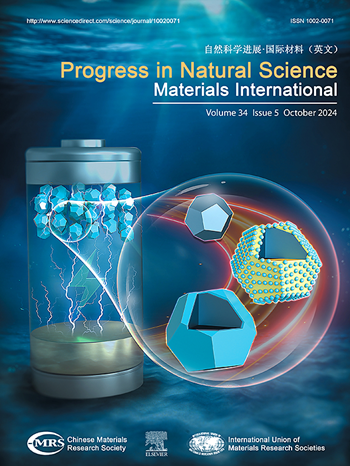Co-MOF-derived stalk-flower like NiCo-LDH homostructure towards boosting electrochemical energy storage
IF 7.1
2区 材料科学
Q2 MATERIALS SCIENCE, MULTIDISCIPLINARY
Progress in Natural Science: Materials International
Pub Date : 2024-12-01
DOI:10.1016/j.pnsc.2024.10.004
引用次数: 0
Abstract
The rational design of the heterostructure of multi-component materials acts on electrochemical properties. However, the effect of structure and component alone on the performance is ignored. Homostructure can reflect the advantages of structural design more directly and fully tap the potential of the material itself. Herein, the homogeneous stereostructure with NiCo-LDH nanostalks (NiCo-LDHS) and NiCo-LDH nanoflowers (NiCo-LDHF) was synthesized through simultaneous Co-MOF in-situ etch and electrodeposition. NiCo-LDHS not only preserves the shape of MOF rods, but also forms a firm adhesion to nickel foam. The coated NiCo-LDHF on NiCo-LDHS increases the loading of pseudocapacity material. As a result of the high capacity of Ni(OH)2, the high conductivity of Co(OH)2, as well as the stalk-flower stereostructure, the NiCo-LDHS-F electrode demonstrates a specific capacity of 2058 F g−1 (13994 mF cm−2) at 1 A g−1, along with an ultrahigh rate capability, retaining 73.9 % of its capacity at 20 A g−1. Moreover, the assembled NiCo-LDHS-F//AC hybrid supercapacitor (HSC) exhibits striking energy and power densities of 48.44 Wh·kg−1 (0.78 mWh·cm−2) and 800 W kg−1 (12.8 mW cm−2), respectively. Notably, after 10,000 consecutive charging and discharging cycles, the device maintains a capacity retention of 85.36 %, demonstrating its good cycling stability. These findings prove the essentiality of designing homogeneous structure for the advancement of energy storage performance.

co - mof衍生的茎花状NiCo-LDH同质结构促进电化学储能
多组分材料异质结构的合理设计影响着材料的电化学性能。然而,忽略了结构和构件本身对性能的影响。同构可以更直接地体现结构设计的优势,充分挖掘材料本身的潜力。本文采用原位刻蚀和电沉积相结合的方法合成了具有NiCo-LDH纳米杆(NiCo-LDHS)和NiCo-LDH纳米花(NiCo-LDHF)的均匀立体结构。NiCo-LDHS不仅保持了MOF棒的形状,而且与泡沫镍形成了牢固的粘附。在NiCo-LDHS表面涂覆NiCo-LDHF,增加了假容量材料的负载。由于Ni(OH)2的高容量,Co(OH)2的高导电性以及茎花立体结构,NiCo-LDHS-F电极在1 a g−1时的比容量为2058 F g−1 (13994 mF cm−2),同时具有超高的倍率能力,在20 a g−1时保持73.9%的容量。此外,组装的NiCo-LDHS-F//AC混合超级电容器(HSC)的能量和功率密度分别为48.44 Wh·kg−1 (0.78 mWh·cm−2)和800 W kg−1 (12.8 mW cm−2)。值得注意的是,在连续10,000次充放电循环后,该设备的容量保持率为85.36%,显示出良好的循环稳定性。这些发现证明了设计均匀结构对于提高储能性能的重要性。
本文章由计算机程序翻译,如有差异,请以英文原文为准。
求助全文
约1分钟内获得全文
求助全文
来源期刊
CiteScore
8.60
自引率
2.10%
发文量
2812
审稿时长
49 days
期刊介绍:
Progress in Natural Science: Materials International provides scientists and engineers throughout the world with a central vehicle for the exchange and dissemination of basic theoretical studies and applied research of advanced materials. The emphasis is placed on original research, both analytical and experimental, which is of permanent interest to engineers and scientists, covering all aspects of new materials and technologies, such as, energy and environmental materials; advanced structural materials; advanced transportation materials, functional and electronic materials; nano-scale and amorphous materials; health and biological materials; materials modeling and simulation; materials characterization; and so on. The latest research achievements and innovative papers in basic theoretical studies and applied research of material science will be carefully selected and promptly reported. Thus, the aim of this Journal is to serve the global materials science and technology community with the latest research findings.
As a service to readers, an international bibliography of recent publications in advanced materials is published bimonthly.

 求助内容:
求助内容: 应助结果提醒方式:
应助结果提醒方式:


